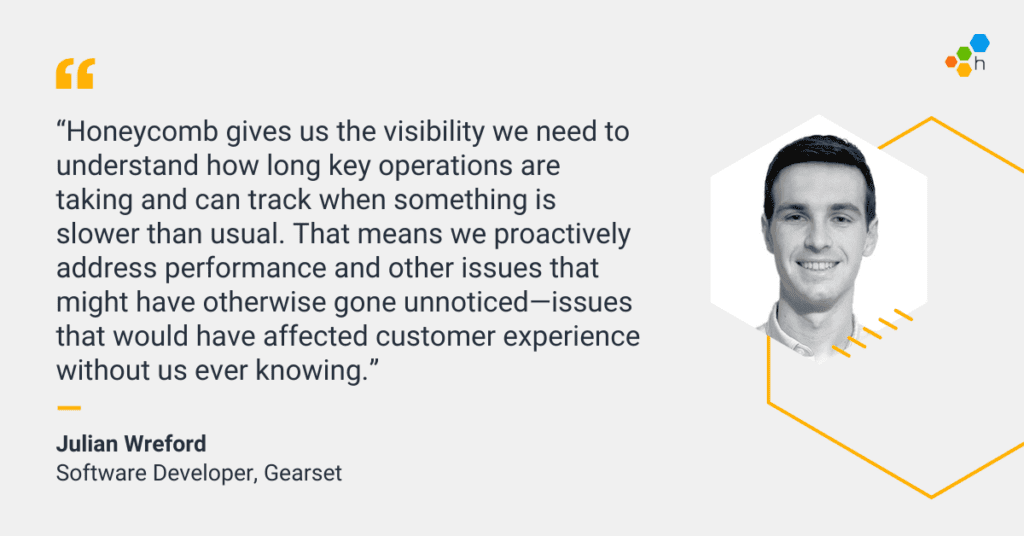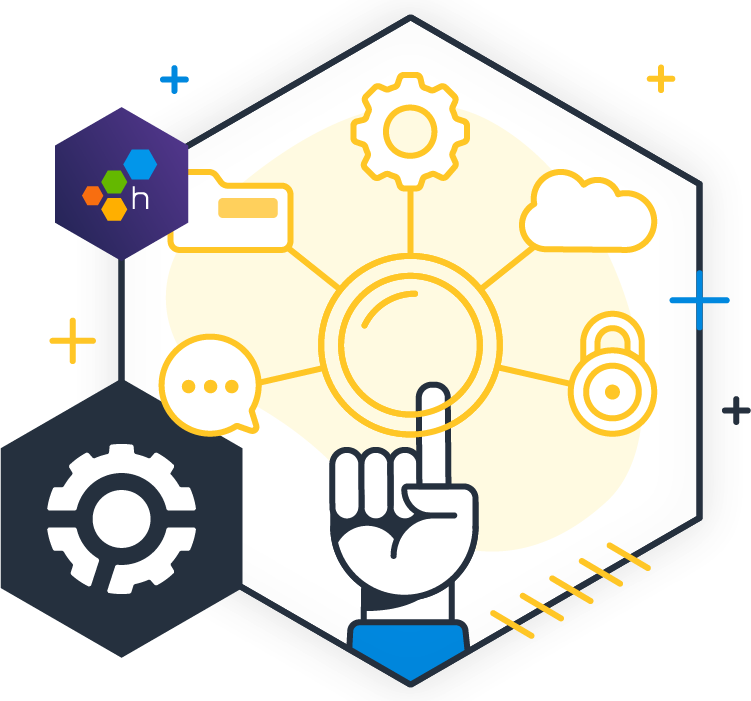Interested in learning more? Book a call with our experts.
Gearset has been revolutionizing Salesforce DevOps since its founding in 2015. The Cambridge-based team set out with a clear mission: to make Salesforce deployments simpler, faster, and more reliable for every team. Today, Gearset’s powerful product suite is trusted by over 2,500 companies worldwide to deploy metadata, automate CI/CD pipelines, seed sandboxes, and secure critical customer data. With a team of more than 300 dedicated professionals, Gearset prides itself on forming strong partnerships that empower their customers to scale DevOps success.
Behind the scenes, Gearset’s infrastructure runs atop Kubernetes across five AWS regions, providing the foundation for a platform designed to handle complexity at scale. But as Gearset grew, so did the demands on its systems. In its early days, the team leaned on logs and other tools to troubleshoot incidents. However, finding the source of an issue often depended on whether the right data had been logged, making it a time-intensive, iterative process to pinpoint the root cause. This approach worked when the company was in its early days, but as its customer base and technical footprint expanded, it became clear they needed a new strategy to handle the increasing complexity.
Gearset knew it was time to level up their observability strategy. To deliver the reliability and responsiveness their customers expected, they needed a more powerful way to pinpoint and solve issues—one that could keep pace with their rapid growth. That’s when they turned to Honeycomb, embracing observability to drive faster, smarter decision-making in the face of production incidents.
Tackling customer-specific challenges
For Gearset, no two customers are the same. As Oli Lane, Software Team Lead at Gearset explained, “Every customer is unique in quite a big way. The shape of their workloads, the size of their orgs, and even the way they use Salesforce can be wildly different. That’s a big challenge for us as we scale.”
These differences create an ever-shifting set of demands, with each new customer bringing their own unique requirements to the table. One day, it might be tackling a massive multi-terabyte backup job. The next, it could involve optimizing workloads to maximize resource utilization across Gearset’s expansive AWS infrastructure.
This variability demands more than just robust infrastructure; it requires deep visibility into how the system performs under different conditions. Before adopting Honeycomb, relying on logs to debug issues was a process that often felt more like detective work than engineering. “A lot of the time, I’d be reading logs and end up having to grab the person who wrote the code or dive into it myself. It could take days just to figure out the source of an issue,” said Julian Wreford, Software Developer at Gearset.
Honeycomb transformed this process. By switching to a trace-first observability model, Gearset’s team gained the ability to map user interactions across their system with clarity and precision. Traces in Honeycomb provide a top-level view of performance, with every operation wrapped in a span.
“It used to be that we’d have vague hunches and throw stopwatches around suspicious code paths, hoping to catch something the next time,” recalled Oli. “Now, we always have top-level timing. If something is slow, we know exactly which operation to focus on.”
Honeycomb’s ability to handle high-cardinality data has taken this even further, enabling Gearset to drill down into the unique nuances of each customer’s workload—a crucial advantage in an environment where no two customers are alike. Gearset’s users leverage Salesforce in wildly different ways, resulting in a broad spectrum of workload shapes, sizes, and complexities. With Honeycomb, the team can group and analyze performance data by virtually any dimension—customer, operation type, region, or workload size—to pinpoint patterns and anomalies.
Oli explained, “If I notice a process taking five minutes for one customer but just two seconds for most others, I can run a query in Honeycomb to group by max duration. From there, I can identify whether it’s just that customer or if there’s a cluster of similar slow cases. That insight lets us fix the issue faster, avoid blind alleys, and even identify trends we hadn’t considered before.”
Fast feedback loops drive confidence in rapid releases
Gearset’s fast-paced development cycles—featuring 10+ releases a week—demand confidence at every step of the process. When something breaks, the team needs quick answers to maintain momentum and prevent issues from slipping into production. Honeycomb has become an integral part of this workflow, enabling Gearset to identify and fix potential problems before customers notice them.
With Honeycomb, every release benefits from a tighter feedback loop. “We release twice a day, so if something changes drastically, we can spot it immediately. By grouping metrics by release version, we can see if a performance duration shifts right after a new version rolls out. That makes it easy to pinpoint where the issue came from and take fast corrective action,” Julian shared. This level of visibility ensures the team stays proactive, addressing problems early and iterating with confidence.
The ability to contextualize events and aggregate data is key. “Now with Honeycomb, we can immediately put an event in context. If something seems unusual, we can check if it’s actually an anomaly or a typical pattern we’ve seen before. For example, maybe the process isn’t taking longer—it’s just that one customer is running it 10 million times when most customers only run it 10 times. Aggregating data by user, version, or workload makes it easier to rule things in or out quickly,” explained Oli.
As Oli noted, “We use Honeycomb’s BubbleUp all the time. With so many variables—like customer configurations, regions, pods, or even version control providers—it’s incredibly helpful to instantly see if everyone with a problem shares a specific attribute or if the issue spans completely unrelated attributes. That immediate clarity is a real time saver.”
Gearset relies on Honeycomb not only to pinpoint the root cause of issues but also to quickly eliminate hypotheses, which helps the development team zero in on the real problem faster. “When we’re investigating with Honeycomb, being able to quickly confirm that something isn’t related saves a huge amount of time. It helps us avoid rabbit holes and focus on what actually matters,” Julian emphasized.
Oli added, “Let’s say a specific pod is having problems because two users on it have seen slow operations. Then, I find a third user with the same issue in a completely different region and on a different pod. That tells me it’s likely a more widespread issue, maybe something introduced in the last release. The ability to rule things out rapidly is super helpful. Generating theories is easy, but being able to quickly eliminate them to find the right root cause is where the value lies.”
By modernizing their observability with Honeycomb, Gearset has tightened its feedback loops and optimized its investigation workflows. The result? Faster fixes within hours rather than days, more confident releases, and a team that can stay ahead of customer-impacting issues—no matter how unique or complex.

Proactively managing customer experience with real-time insights
With Honeycomb’s insights, Gearset can now take a more proactive approach to managing customer experience. They have a clear, real-time understanding of how their system performs under various workloads, including edge cases they hadn’t anticipated.
“Honeycomb gives us the visibility we need to understand how long key operations are taking and can track when something is slower than usual. That means we proactively address performance and other issues that might have otherwise gone unnoticed—issues that would have affected customer experience without us ever knowing.” The baseline of performance metrics Honeycomb provides helps Gearset spot these slowdowns, even if they’re gradual and compounded over time due to new features being added.
Julian added, “Honeycomb also helps us be much more informed and specific in our customer communications. We can now clearly differentiate between issues caused by our system and those that are due to downstream providers. For example, if a customer is experiencing a performance issue, we can determine whether it’s related to a dependency like pulling data from a third-party provider. If it’s out of our hands, we can explain that and try to find a workaround, but if it’s an issue on our end, we can offer a more targeted solution. This level of detail allows us to frame the conversation in a much more constructive way, making it easier to manage customer expectations.”
This improved transparency has a direct impact on customer satisfaction. By leveraging the insights available in Honeycomb to explain exactly what’s going on, Gearset can more effectively manage expectations and build stronger relationships with customers.

At a glance
About
Gearset is a leading DevOps platform specifically designed for Salesforce. It empowers teams to manage and deploy Salesforce applications with ease, providing seamless backup, version control, automated testing, and continuous integration and continuous delivery (CI/CD). Gearset helps businesses maintain the integrity of their Salesforce environments while accelerating the release of new features. With powerful analytics and reporting capabilities, Gearset enables teams to optimize their workflows and monitor the health of their Salesforce instances, ensuring high-quality, reliable deployments every time.
Industry
DevOps & Software Development
Products
Honeycomb platform
Use cases
Incident debugging
Results
- Gained a clearer understanding of system behavior, making it easier to pinpoint issues during incidents with Honeycomb’s powerful tracing capabilities
- Increased diagnostic accuracy, enabling the team to move from uncertainty to quicker, data-backed confirmations of their hypotheses through Honeycomb’s high-fidelity data
- Reduced investigation times from days to hours, as engineers leverage Honeycomb to eliminate guesswork and pinpoint the root cause of issues with confidence
- Enabled faster feedback loops, providing the team with real-time insights to support more than 10 weekly releases
- Enhanced customer experience by leveraging Honeycomb’s insights to proactively monitor system performance and address issues before they impact customers
- Strengthened customer communications by providing the data needed for informed conversations, allowing Gearset to set more realistic expectations through data-driven insights








